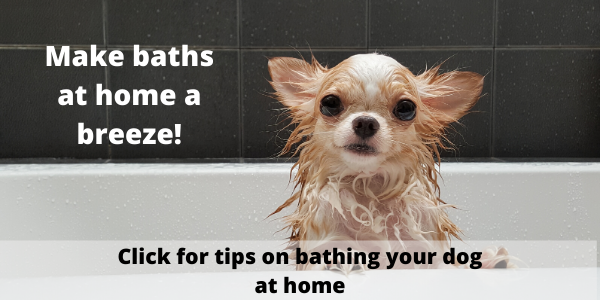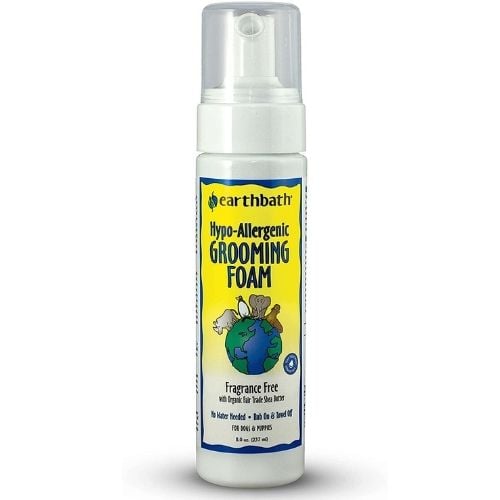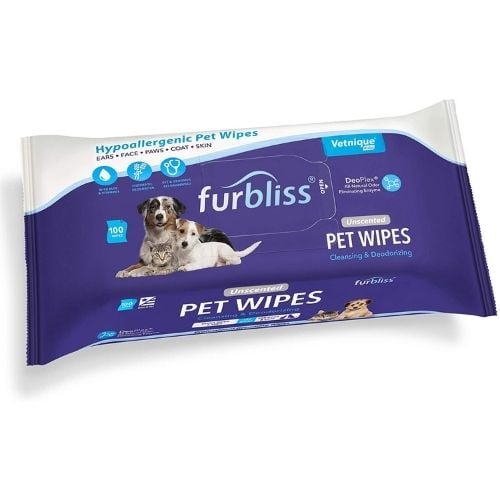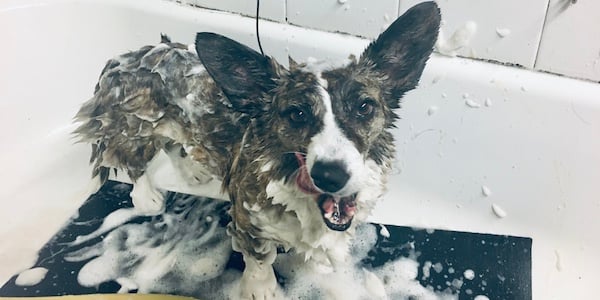
It's not uncommon for dogs to absolutely despise their bath time, even if they're otherwise happy to jump in lakes or rivers, or even a kiddie pool in the backyard.
The easiest way around this is being introduced slowly and in a positive way to the bath experience as a puppy. But even if your dog is grown, all hope is not lost!
Below are some steps to work on helping your dog better tolerate bath time, but it helps to connect with a certified dog trainer for a personalized plan on how to counter condition the bathing experience.
If you prefer to have your dog bathed or groomed professionally, choosing the right groomer is essential for building positive "spa day" experiences. Read our article "Finding a Groomer Your Dog Will Love and Trust" to learn what you should ask a potential groomer before you book an appointment.
Create Positive Associations With Different Parts of the Bathing Process
Break the bath experience into smaller pieces and pair with positive things, like food and treats.
Brushing
Just being brushed can make some dogs uncomfortable (especially if they've been matted in the past, as brushing out tangled fur is painful).
- Step One: Show them the brush and then give them a treat.
- Step Two: Touch them gently with the brush, and then give them a treat.
- Step Three: Brush a small section for a second or two, then stop and give another treat.
- Step Four: Continue slowly adding more time to brushing in between treats. Stop if your dog shows signs of stress or tries to move away. If this happens, take a break and go back to a previous step that your dog did well with.
What this is doing is creating the association of Brush = Treat. Do this for just a minute or two at a time, slowly working towards longer brushing sessions. It can take some time for your dog to build up to full body brushing in one session.
It could take weeks (or even longer for dogs with previous negative brushing experiences) to get your dog comfortable with brushing — but it's worth it.
To learn more about what brush works best or your dog's coat type, as well as tips for how to brush the right way, read our article "Caring for Your Dog's Coat: Brushing, Combing, and Mats."
PRO TIP: Spend Some "Water-Free" Time In The Tub!
Bathing Without Water
Help your dog feel more comfortable in the tub without getting wet. A great time to do this is when you're getting ready for the day and brushing your teeth or doing your hair in the bathroom.
- Step One: Put a comfy blanket or their bed in the tub for them to sit or lay down on, and give them a stuffed KONG to work on.
- Step Two: Have them practice their basic skills in the tub, like Sit or Down. Lots of treats and praise, combined with the absence of the unpleasant part of actual bathing, will help them feel better about getting in the tub when it is actually time for turning on the water.
- Step Three: Train your dog to hop in and out of the tub on their own. If your tub has high walls they might need a little boost from you, but reward them for even just putting their front paws on the edge. If you have a small dog that won't be able to get in or out by themselves, practice picking them up and putting them in. Give lots of treats and praise both in and out of the tub!
- Step Four: Practice rubbing your dog all over without water and shampoo while they're in the tub, so they get more comfortable with being handled while staying still.
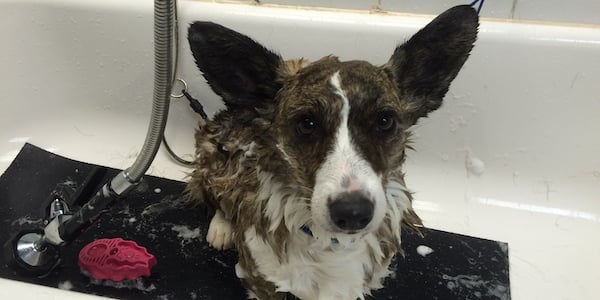
Bathing With Water
Move on to turning on the water with your dog in the tub.
- Step One: Turn on the water, but do not spray it on your dog. Turn the water on = treat! Only have the water on for small amounts of time at first, helping your dog acclimate to the sound of water in the tub.
- Step Two: Build up to rinsing only a small area, then giving a treat.
- Step Three: Take lots of breaks as you work up to longer periods of water on and rinsing larger areas of their body.
PRO TIP: Using a shower head attachment sprayer makes it easier for you to introduce short spurts of water on and off again. You don't have to constantly turn the faucet, and a sprayer gives you more control in rinsing than a bucket or pitcher of water.
Watch this video by K9 of Mine to see how they breaks down the bathing process and makes it more comfortable for her dog using positive reinforcement:
Blow Drying
If you need to use a blow dryer for drying your dog, introduce it to them in small increments ahead of time, paired with treats. Consider skipping a blow-dry, and thoroughly towel drying the first few times while your dog gets desensitized to the dryer.
I suggest practicing these following blow-drying desensitization steps separately from other bathing practice when your dog is dry to begin with.
- Step One: Show the blow dryer to your dog, then give them a treat. Blow dryer = treat! Repeat a few times to build a positive association with seeing the blow dryer appear.
- Step Two: Turn the blow dryer on, using the lowest (and quietest) setting. Make sure the air flow isn't on your dog just yet. Toss a treat, then turn the blow dryer off. You're now creating a positive association with the sound of the blow dryer, which can be quite loud for your dog's sensitive ears.
- Step Three: Slowly increase the time the blow dryer is turned on, giving treats to your dog throughout. Once the blow dryer turns off, treats stop.
- Step Four: Start to introduce movement of the blow dryer as it's turned on while treating your dog. You're still not turning the airflow onto your dog just yet, but introducing the different sound the dryer makes as it's moving back and forth. I like to do this against my own hand or hair so it sounds realistic. Start with a shorter period of time when you introduce this step, building back up to longer as your dog acclimates.
- Step Five: Begin to introduce the feel of the airflow on your dog's body. Remember — short and sweet is the key! Hold the dryer from a good distance and avoid blowing air in and around your dog's face or ears (many dogs are often sensitive about blow-drying on their feet as well).
Preventive Vet pup Finnegan, a Portuguese Water Dog, used to bark when his owner turned on the blow dryer. After working on the above desensitization steps for a few weeks, he now relaxes while he gets blown dry.
His owner took advantage of daily training opportunities by keeping treats on the bathroom counter and rewarding him while she dried her own hair. Watch this video to see some examples from his training:
Go Slow
When you're bathing your dog, take it nice and slow so you don't overwhelm them. You might not be able to get them as clean as you'd like the first couple of times, but it's better to have a positive — albeit incomplete — experience, rather than a forced activity and negative association with a bath.
Note: Do always try to towel dry as much as possible, as you don't want your dog to develop ear infections or skin issues like hot spots.
Read more about how to bathe your dog in our article "Tips for Bathing Your Dog at Home."
Enlist Help From Family or Friends
Trying to bathe your dog and give them treats at the same time can be tricky! Ask a family member or friend to help by keeping your dog busy with praise and treats while you get down to the dirty work. Or, if you're alone, use the peanut butter smearing tactic on your bathtub walls to provide a more continuous distraction for your dog.
You can also use a Lick Lick Pad to make this a less messy option in your tub — Finnegan took to his Lick Lick Pad right away (hard to resist some peanut butter!).

What to Do If You Have to Wash a Dog Who Hates Baths
While you work on the steps outlined above, there will be times when you have to clean your dog. They might have decided that a romp in a mud pit seemed fun, or perhaps they had a run-in with a skunk. You don't want all your hard work in practicing positive bathing experiences to go down the drain.
- Use lots of distracting high-value rewards: Try and make the experience as positive as you can. While distraction treating is not the same as counter conditioning, it can still help make the bath less stressful. Learn about how to determine what your dog considers "high-value" in our article "What Kinds of Treats to Use When Training Your Dog." Or, if you want to try your hand at making your own high-value treats, check out our Homemade High-Value Treat Recipe here.
In extreme cases, a dog will be too stressed to even want to lick peanut butter or take a treat. Praise them throughout and still offer them a treat, even if they refuse it. Your calm and steady demeanor will go a long way in keeping the negative association from becoming worse than it already is. - Waterless bathing: There are a few products available that can help extend the time between full bathing, such as cleansing wipes or dry shampoos. A dry or waterless shampoo is great to use on dogs with a thick coat or hair-type coat. Earthbath Waterless Grooming Foam can be used for dogs 6 weeks or older. For dogs with short or smooth coats, often a wipe is the easiest option. Furbliss Hypoallergenic Wipes are thick enough for one wipe to last for a full body and paw wipe down, depending on how dirty/muddy your dog is, and are available in unscented and a "refreshing" scent.
- Schedule bathing with a professional groomer: Finding a groomer to give your dog a bath can make it easier on everyone. A Fear Free Certified groomer will work with you to continue counter conditioning and desensitization practice.
Often just having the bath experience in a different environment than at home can help dogs build more positive associations — especially if you take the time to visit the grooming salon for "happy visits" in between bath appointments. Professional groomers can often get the bath done more quickly and thoroughly than you might be able to at home, and they have tools and techniques to help nervous dogs.

With practice and patience, your dog can learn to tolerate bath time, and bathing your dog at home will be easier and less stress for all!
Have you been working on helping your dog feel better about bath time? Share your tips in the comments below!


